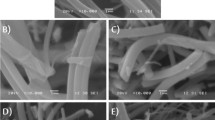Abstract
Long titanate nanofibers (typically 10–500 µm in length and 20–50 nm in diameter) were successfully prepared in high yield by the direct hydrothermal processing using natural rutile as a starting material. Fourier transform infrared spectroscopy, transmission electron microscopy, energy dispersive x-ray spectroscopy, electron diffraction, and x-ray diffraction demonstrated that the as-synthesized nanofibers presumably consisted of sodium hydrogen trititanate [(Na,H)2Ti3O7, e.g., Na0.4H1.6Ti3O7] including some hexatitanate-type defects [(Na,H)2Ti6O13]. A partial topotactic condensation model explained their nanostructure well. Although the as-synthesized fibers are defective, they can be cured by a post-heat-treatment in air. The direct hydrothermal treatment for natural rutile will be a promising low-cost process for one-dimensional nanomaterials, which can act not only as a reaction step but also as a purification step.
Similar content being viewed by others
References
D. Li and Y.N. Xia: Fabrication of titania nanofibers by electrospinning. Nano Lett. 3, 555 (2003).
S. Yoo, S.A. Akbar, and K.H. Sandhage: Nanocarving of buld titania crystals into oriented arrays of single-crystal nanofibers via reaction with hydrogen-bearing gas. Adv. Mater. 16, 260 (2004).
P. Hoyer: Formation of titanium oxide nanotube array. Langmuir 12, 1411 (1996).
H. Imai, Y. Takei, K. Shimizu, M. Matsuda, and H. Hirashima: Direct preparation of anatase TiO2 nanotubes in porous alumina membranes. J. Mater. Chem. 9, 2971 (1999).
D. Gong, C.A. Grimes, O.K. Varghese, W.C. Hu, R.S. Singh, Z. Chen, and E.C. Dickey: Titanium oxide nanotube arrays prepared by anodic oxidation. J. Mater. Res. 16, 3331 (2001).
J. Sun, L. Gao, and Q.H. Zhang: TiO2 tubes synthesized by using ammonium sulfate and carbon nanotubes as templates. J. Mater. Sci. Lett. 22, 339 (2003).
S. Kobayashi, K. Hanabusa, N. Hamasaki, M. Kimura, H. Shirai, and S. Shinkai: Preparation of TiO2 hollow-fibers using supramolecular assemblies. Chem. Mater. 12, 1523 (2000).
T. Kasuga, M. Hiramatsu, A. Hoson, T. Sekino, and K. Niihara: Formation of titanium oxide nanotube. Langmuir 14, 3160 (1998).
T. Kasuga, M. Hiramatsu, A. Hoson, T. Sekino, and K. Niihara: Titania nanotubes prepared by chemical processing. Adv. Mater. 11, 1307 (1999).
G.H. Du, Q. Chen, R.C. Che, Z.Y. Yuan, and L.M. Peng: Preparation and structure analysis of titanium oxide nanotubes. Appl. Phys. Lett. 79, 3702 (2001).
Q. Chen, G.H. Du, S. Zhang, and L.M. Peng: The structure of trititanate nanotubes. Acta Crystallogr. B 58, 587 (2002).
Q. Chen, W.Z. Zhou, G.H. Du, and L.M. Peng: Trititanate nanotubes made via a single alkali treatment. Adv. Mater. 14, 1208 (2002).
S. Zhang, L.M. Peng, Q. Chen, G.H. Du, G. Dawson, and W.Z. Zhou: Formation mechanism of H2Ti3O7 nanotubes. Phys. Rev. Lett. 91, 259103 (2003).
X. Sun and Y. Li: Synthesis and characterization of ionexchangeable titanate nanotubes. Chem. Eur. J. 9, 2229 (2003).
R.Z. Ma, Y. Bando, and T. Sasaki: Nanotubes of lepidocrocite titanates. Chem. Phys. Lett. 380, 577 (2003).
J. Yang, Z. Jin, X. Wang, W. Li, J. Zhang, S. Zhang, X. Guo and Z. Zhang: Study on composition, structure and formation process of Nanotube Na2Ti2O4(OH)2. Darton Trans. 20, 3398–3901 (2003).
Y. Suzuki and S. Yoshikawa: Synthesis and thermal analyses of TiO2-derived nanotubes prepared by the hydrothermal method. J. Mater. Res. 19, 982 (2004).
Y. Suzuki, S. Sakulkhaemaruethai, R. Yoshida, and S. Yoshikawa: Heat treatment effect on the structure of TiO2-derived nanotubes prepared by hydrothermal method. Ceram. Trans. 159, 185 (2005).
A.R. Armstrong, G. Armstrong, J. Canales, and P.G. Bruce: TiO2–B Nanowires. Angew. Chem. Int. Ed. Engl. 43, 2286 (2004).
G.H. Du, Q. Chen, P.D. Han, Y. Yu, and L.M. Peng: Potassium titanate nanowires: Structure, growth, and optical properties. Phys. Rev. B 67, 035323 (2003).
Y. Fujiki and T. Mitsuhashi: Preparation of K2Ti6O13 fibers and its related composite fibers using natural rutile or anatase ores—As derivatives of K2Ti2O5 fibers. J. Ceram. Soc. Jpn. 96, 1109 (1988), in Japanese.
J. Hong, J. Cao, J. Sun, H. Li, H. Chen, and M. Wang: Electronic structure of titanium oxide nanotubes. Chem. Phys. Lett. 380, 366 (2003).
T. Sekino: Does the one-dimensional nanospace in titania nanotubes contribute to the functionalization? in Preprints of the 6th Kansai Branch Forum for Young Scientists and Engineers on Ceramic Studies, The Ceramic Society of Japan, 2003, p. 28 (in Japanese).
G. Busca, G. Ramis, J.M.G. Amores, V.S. Escribano, and P. Piaggio: FT Raman and FTIR studies of titanias and metatitanate powders. J. Chem. Soc., Faraday Trans. 90, 3181 (1994).
G.W. Peng, S.K. Chen, and H.S. Liu: Infrared-absorption spectra and their correlation with the Ti–O bond-length variations for TiO2 (rutile), Na-titanates, and Na-titanosilicate (natisite, Na2TiOSiO4). Appl. Spectrosc. 49, 1646 (1995).
T.P. Feist and P.K. Davies: The soft chemical synthesis of TiO2 (B) from layered titanates. J. Solid State Chem. 101, 275 (1992).
S. Andersson and A.D. Wadsley: The structures of Na2Ti6O13 and Rb2Ti6O13 and the alkali metal titanates. Acta Crystallogr. 15, 194 (1962).
S. Pavasupree, Y. Suzuki, S. Yoshikawa, and R. Kawahata: Unpublished work.
Author information
Authors and Affiliations
Corresponding author
Rights and permissions
About this article
Cite this article
Suzuki, Y., Pavasupree, S., Yoshikawa, S. et al. Natural rutile-derived titanate nanofibers prepared by direct hydrothermal processing. Journal of Materials Research 20, 1063–1070 (2005). https://doi.org/10.1557/JMR.2005.0135
Received:
Accepted:
Published:
Issue Date:
DOI: https://doi.org/10.1557/JMR.2005.0135




